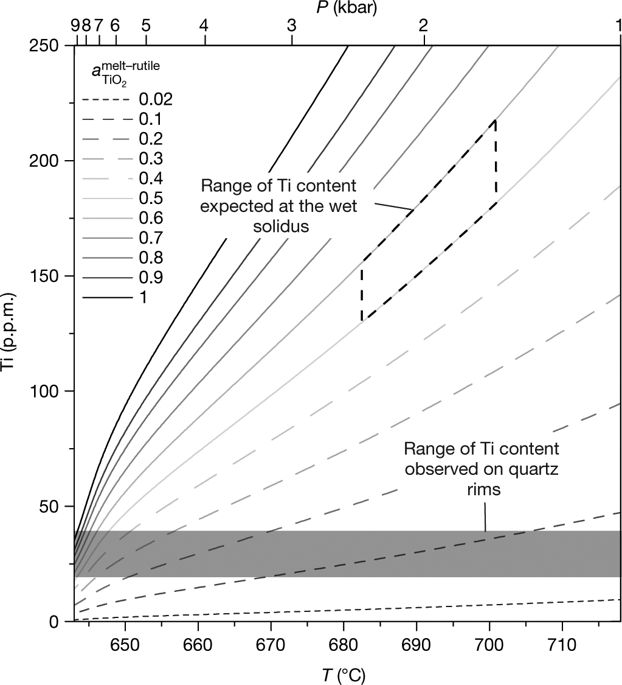Our official English website, www.x-mol.net, welcomes your
feedback! (Note: you will need to create a separate account there.)
Low-temperature crystallization of granites and the implications for crustal magmatism
Nature ( IF 50.5 ) Pub Date : 2018-06-27 , DOI: 10.1038/s41586-018-0264-2 Michael R. Ackerson , B. O. Mysen , N. D. Tailby , E. B. Watson
Nature ( IF 50.5 ) Pub Date : 2018-06-27 , DOI: 10.1038/s41586-018-0264-2 Michael R. Ackerson , B. O. Mysen , N. D. Tailby , E. B. Watson

|
The structure and composition of granites provide clues to the nature of silicic volcanism, the formation of continents, and the rheological and thermal properties of the Earth's upper crust as far back as the Hadean eon during the nascent stages of the planet’s formation1–4. The temperature of granite crystallization underpins our thinking about many of these phenomena, but evidence is emerging that this temperature may not be well constrained. The prevailing paradigm holds that granitic mineral assemblages crystallize entirely at or above about 650–700 degrees Celsius5–7. The granitoids of the Tuolumne Intrusive Suite in California tell a different story. Here we show that quartz crystals in Tuolumne samples record crystallization temperatures of 474–561 degrees Celsius. Titanium-in-quartz thermobarometry and diffusion modelling of titanium concentrations in quartz indicate that a sizeable proportion of the mineral assemblage of granitic rocks (for example, more than 80 per cent of the quartz) crystallizes about 100–200 degrees Celsius below the accepted solidus. This has widespread implications. Traditional models of magma formation require high-temperature magma bodies, but new data8,9 suggest that volcanic rocks spend most of their existence at low temperatures; because granites are the intrusive complements of volcanic rocks, our downward revision of granite crystallization temperatures supports the observations of cold magma storage. It also affects the link between volcanoes, ore deposits and granites: ore bodies are fed by the release of fluids from granites below them in the crustal column; thus, if granitic fluids are hundreds of degrees cooler than previously thought, this has implications for research on porphyry ore deposits. Geophysical interpretations of the thermal structure of the crust and the temperature of active magmatic systems will also be affected.Thermobarometry and diffusion modelling in quartz crystals show that some granites may crystallize at much lower temperatures than we had thought, possibly explaining observations of cold magma storage.
中文翻译:

花岗岩的低温结晶及其对地壳岩浆作用的影响
花岗岩的结构和成分为了解硅质火山作用的性质、大陆的形成以及地球上地壳的流变学和热学性质提供了线索,该流变学和热学性质可以追溯到地球形成的初期阶段 1-4。花岗岩结晶的温度支持我们对其中许多现象的思考,但有证据表明该温度可能没有得到很好的限制。普遍的范式认为,花岗岩矿物组合在大约 650-700 摄氏度或更高的温度下完全结晶5-7。加利福尼亚 Tuolumne Intrusive Suite 的花岗岩讲述了一个不同的故事。在这里,我们展示了 Tuolumne 样品中的石英晶体记录的结晶温度为 474-561 摄氏度。石英中钛的热气压测量法和石英中钛浓度的扩散模型表明,相当大比例的花岗岩矿物组合(例如,超过 80% 的石英)在可接受的固相线以下约 100-200 摄氏度结晶. 这具有广泛的影响。传统的岩浆形成模型需要高温岩浆体,但新数据 8,9 表明火山岩的大部分存在时间都在低温下;因为花岗岩是火山岩的侵入体,我们对花岗岩结晶温度的向下修正支持了对冷岩浆储存的观察。它还影响火山、矿床和花岗岩之间的联系:矿体由地壳柱中位于其下方的花岗岩释放的流体供给;因此,如果花岗岩流体比以前认为的温度低数百度,这将对斑岩矿床的研究产生影响。地壳热结构和活动岩浆系统温度的地球物理解释也将受到影响。 石英晶体中的热压测量和扩散模型表明,一些花岗岩可能在比我们想象的低得多的温度下结晶,这可能解释了对冷岩浆储存的观察.
更新日期:2018-06-27
中文翻译:

花岗岩的低温结晶及其对地壳岩浆作用的影响
花岗岩的结构和成分为了解硅质火山作用的性质、大陆的形成以及地球上地壳的流变学和热学性质提供了线索,该流变学和热学性质可以追溯到地球形成的初期阶段 1-4。花岗岩结晶的温度支持我们对其中许多现象的思考,但有证据表明该温度可能没有得到很好的限制。普遍的范式认为,花岗岩矿物组合在大约 650-700 摄氏度或更高的温度下完全结晶5-7。加利福尼亚 Tuolumne Intrusive Suite 的花岗岩讲述了一个不同的故事。在这里,我们展示了 Tuolumne 样品中的石英晶体记录的结晶温度为 474-561 摄氏度。石英中钛的热气压测量法和石英中钛浓度的扩散模型表明,相当大比例的花岗岩矿物组合(例如,超过 80% 的石英)在可接受的固相线以下约 100-200 摄氏度结晶. 这具有广泛的影响。传统的岩浆形成模型需要高温岩浆体,但新数据 8,9 表明火山岩的大部分存在时间都在低温下;因为花岗岩是火山岩的侵入体,我们对花岗岩结晶温度的向下修正支持了对冷岩浆储存的观察。它还影响火山、矿床和花岗岩之间的联系:矿体由地壳柱中位于其下方的花岗岩释放的流体供给;因此,如果花岗岩流体比以前认为的温度低数百度,这将对斑岩矿床的研究产生影响。地壳热结构和活动岩浆系统温度的地球物理解释也将受到影响。 石英晶体中的热压测量和扩散模型表明,一些花岗岩可能在比我们想象的低得多的温度下结晶,这可能解释了对冷岩浆储存的观察.









































 京公网安备 11010802027423号
京公网安备 11010802027423号